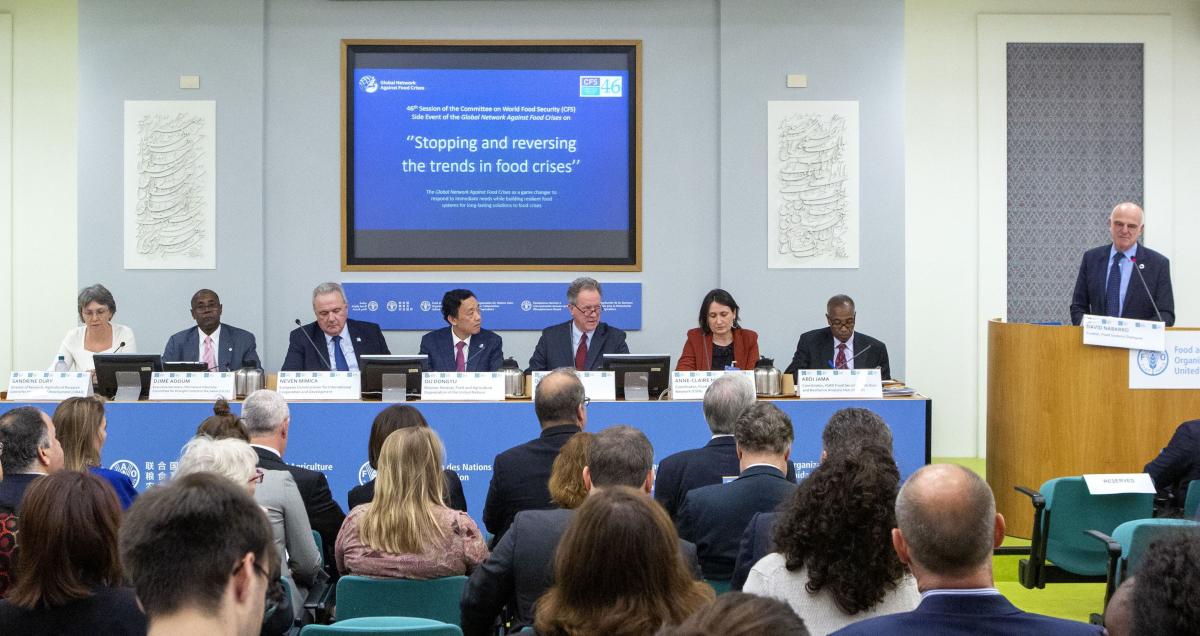Just out 27 October 2025
- Home
- Press area
- Press releases
- Report on threats to food systems
A new report reveals the threats to food systems

At the presentation in Rome of the report Food systems at risk: new trends and challenges, L to R: CIRAD's Sandrine Dury, CILSS Executive Secretary Djimé Adoum, EU Commissioner for International Cooperation and Development Neven Mimica, FAO DG Qu Dongyu, WFP Executive Director David Beasley, FSIN Coordinator Anne-Claire Mouilliez, Head of IFRAH Abdi Jama and David Nabarro, Professor of Global Health at Imperial College London © FAO
The food security paradox
Never in human history has global food production per inhabitant been so high. It already exceeds nutritional requirements, and is continuing to rise. However, under-nutrition has been on the rise since 2015, after falling for decades. Is this a glitch or a real underlying trend? The latter assumption unfortunately looks likely, given the many threats to food systems.
The thing is, these systems do not just produce food. They also provide jobs, revenue and infrastructures. They play a central role in the lives of rural people, structure territories, link rural and urban areas, and have numerous effects on the environment, biodiversity and climate change. All of those aspects must be considered when studying and assessing food systems, as observed in a new report presented at the 46th meeting of the Committee on World Food Security .
Sandrine Dury, an economist with CIRAD, the report's lead author, presented the risks of failing to take action and continuing past trends, while stressing the need to change both the technical and governance models applied to food systems.
Food systems: the risks are increasingly urgent, serious and combined
As things currently stand, food systems are under several simultaneous threats, which suggests food crises could become increasingly common.
- Galloping population growth in some countries will inevitably increase demand for food and pressure on land. That growth looks like being particularly substantial in low-income countries, particularly in sub-Saharan Africa.
- Dietary changes mean a triple malnutrition burden (under-nutrition, deficiencies and diseases of plenty) and new health risks (both microbiological and chemical).
- Job creation, particularly in rural areas, in low-income countries is a major issue for food security. Food systems, notably food processing, are a major source of jobs, particularly for women.
- Environmental degradation is gaining speed and affects all countries. It is a threat to agricultural production on several levels: falling yields, pollination issues, new diseases, increasingly frequent climatic accidents, etc.
- Global markets are likely to be tighter and more unstable in future.
- Natural disasters and conflicts cause displacement and migration, which are largely responsible for current increased food insecurity. These movements threaten food systems in host regions, with a domino effect of new crises.
Paying greater attention to resilience pathways and local solutions
"This combination of risks puts us in an unprecedented situation in which snowball effects have been observed and the point of no return has been reached in some fields, such as biodiversity" , CIRAD's Sandrine Dury stresses. However, we must not let this alarming picture shock us into inaction. Many communities already live with these constraints. We must look more closely at their capacity for resilience and how they find new solutions and make use of existing ones. There is no magic bullet; the solutions depend on the local situation and mean recognizing the importance of local players and their dynamics.
Reference
Dury, S., Bendjebbar, P., Hainzelin, E., Giordano, T. and Bricas, N., eds. 2019. Food Systems at risk: new trends and challenges. Rome, Montpellier, Brussels, FAO, CIRAD and European Commission.



























